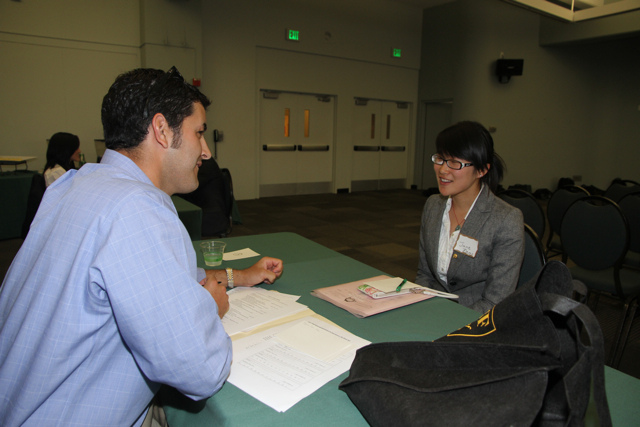
Hiring for Attitude
Hiring for Attitude https://csuiteold.c-suitenetwork.com/wp-content/uploads/2014/10/4606535751_dd3f586526_z.jpg 640 427 C-Suite Network https://csuiteold.c-suitenetwork.com/wp-content/uploads/2014/10/4606535751_dd3f586526_z.jpgby Karolynn St-Pierre

Recent studies have found nearly half of newly hired employees fail within their first 18 months at a job. Contrary to what you might expect, technical skills are not the main reason new hires fail; instead, poor interpersonal skills dominate the list. These are weaknesses many of their managers admit were missed during the interview process. About a quarter of new hires fail because they cannot accept feedback, while others are unable to understand and manage emotions. Nearly a third of new hires fail because they aren’t motivated to excel or because they have the wrong temperament for the job.
The failure rate for new hires is distressing, but it shouldn’t be a surprise. The vast majority of managers reported that, in hindsight, they picked up subtle clues during the interview process that these employees might be headed for trouble. During the interviews, they were too focused on other issues, too pressed for time or lacked confidence in their interviewing abilities. The typical interview process concentrates on ensuring that new hires are technically competent. But do technical skills really matter if the employee isn’t willing to improve, alienates their coworkers, lacks drive or has the wrong personality for the job?
Why Typical Interviews Don’t Reveal Attitude
Highly perceptive and psychologically savvy interviewers can assess employees’ interpersonal skills — especially in the key areas of coachability, emotional intelligence, motivation and temperament. But many managers lack both the training to accurately read and assess candidates as well as the confidence to act even when their assessments are correct.
Hiring failures can be prevented if managers focus less on technical competence and more on interpersonal skills during the interview process. Technical competence remains the dominant interview subject because it’s easy to assess. Still, technical prowess is a bad predictor of whether a newly hired employee will succeed or fail. The financial cost of hiring failures, added to the opportunity cost of not hiring high performers, can be millions of dollars — even for small companies.
Identifying Your High-Performer Attitudes
Hiring for attitude doesn’t mean looking for every possible great attitude. The goal is to determine the key attitudes that matter most to your customers and that bring the greatest benefit to your organization. It’s worth remembering there is no such thing as the perfect candidate — just as there are no perfect attitudes. There are attitudes and candidates that are right for your organization.
The best place to go for this is to your current high performers. Consider the people who are an absolute pleasure to be with and who make your job more enjoyable and easier to do. These are the employees you would clone if you could because they bring so much to the organization. Thinking about them, ask yourself: What are the distinctive attitudes that make these people such a joy to work with?
Some examples that may match your choice team:
- They take ownership of problems
- They are highly collaborative
- They aren’t afraid to make mistakes
- They meet commitments
- They are empathetic towards customers’ and colleagues’ needs
Your list of attitudes will be unique to your organization and should not exceed 10 items.
Finding Your Low-Performer Attitudes
The only way to ensure you’ve found a true high performer is to make sure the candidate doesn’t possess the low performer traits that impede success. Low performers and their negative attitudes suck the energy and enthusiasm out of everyone with whom they interact. Internally, they drag down valuable employees and make co-workers so frustrated and miserable they quit.
On the service side, customers and clients who come in contact with low performers tend to think twice before they bring their business back. With your low-performing folks in mind, ask yourself: What are the attitudes these folks have that bring everyone down?
Examples of your responses might include:
- They always find the negative
- They gossip
- They respond to feedback with an argument
- They only do the bare minimum expected of them
- They get overwhelmed by multiple demands and priorities
- They always find someone else to blame for their mistakes
- They’re unwilling to leave their comfort zone
As with the high-performer attitudes, your responses will be unique to your organization and should not exceed 10 items.
Interview Questions to Avoid
You’ve assembled your lists of traits to seek and traits to avoid; now you can use those to create effective interview questions. Before we review the questions you should be asking, let’s eliminate some questions you should avoid.
Here are some of the biggies: “Tell me about yourself.” “What are your strengths?” “What are your weaknesses?” These are not necessarily inherently bad questions, but they are common and clichéd. When you ask questions candidates are expecting, you’re guaranteed to get canned, rehearsed answers that waste everyone’s time.
Another bad question is the hypothetical question: “If you were an animal, what kind of animal would you be?” Now, if you knew, for example, that every high performer in your organization said cheetah, and every low performer said elephant, this might be a valid question. But until you know that, these are just quirky, nonsensical questions that are useless to your hiring process and take up time.
Finally, one of the most common bad question types we see is the leading question: “So listen, Mark, we have a team-friendly, family oriented type of culture here. You are going to fit well into this culture, right?” A candidate would have to be idiotic not to know and provide the correct answer. When you hint the answer, the effectiveness of your question is lost.
How to Ask Questions that Elicit Honest Responses
Before you start formulating rote questions to replace the clichés, it’s important to consider your answers to High Performers Attitudes and Low Performers Attitudes above. These reveal the most important attitudinal characteristics for success in your organization, as well as the characteristics your organization should avoid.
With your list in hand, you’re ready to start building your questions. And here are two questioning techniques we recommend:
- The tried-and-true behavioral interviewing technique, e.g. “Tell me about a time when…” This well-known question construction is designed to elicit a past situation and how your candidate reacted to it.
- The hanging question technique. Pinpoint a real-life scenario your candidate might encounter on the job. Common scenarios include when an employee is given an assignment they don’t agree with, or when specifications for a project are changed at the last minute, or when someone is given an assignment outside of their job role. Finding a challenging situation common to your organization is the key to developing an effective hanging question.
The Perfect 4-Step Interview Question
The number one reason why new hires fail is that they are not coachable. A high performance workplace is dependent upon employees who accept and implement feedback from bosses, colleagues, customers and other key players. There is no point investing time and energy in people who do not respond positively to feedback. Discovering coachability during the interview process is not easy. So we developed and tested a four-step question technique that will allow you to easily identify which candidates are coachable.
- Make Them Believe You’re Going to Talk with Their Previous Boss.
Begin by asking applicants for the full name of their present or most recent boss. Once you’ve got the name (e.g. Kate Johnson), confirm the spelling. In doing this, you create a situation where the applicant believes you’re actually going to call their boss. If they believe that, they’re much more likely to be truthful in their responses to the hiring questions you ask. - Ask Them to Describe Their Boss.
A simple way to do this is to ask, “Tell me about what Kate was like as a boss.” The answer the applicant provides will give you some hints about what they’re looking for in a boss. If their last boss sounds like you, and they loved working for him or her, that’s a great sign. - Ask Them What Their Boss Considered Their Strengths
This is easily done by asking, “When I talk to Kate, what will she tell me are your biggest strengths?” This question has two purposes. First, before you start asking about their weaknesses, it’s nice to start with a more pleasant question. Asking about their strengths gets the candidate talking and keeps them comfortable with you. Second, it gives you an honest look at the qualities that they like best about themselves. - Ask Them What Their Boss Considered Their Weaknesses.
This can be accomplished with a question as simple as, “Now everyone has some weaknesses, so when I talk to Kate, what will she tell me yours are?” This is the most critical question, but it only works if you’ve completed the previous three steps. In fact, if you do the first three steps successfully, you might be shocked at the level of honesty you elicit with this last question. Iif they can’t put themselves in their boss’ shoes and anticipate their assessment, they’re not coachable. And If they’re not coachable, they’re going to be a nightmare to manage.
Putting It All Together
Technical skills are a critical element of any employee’s job performance, and they absolutely must be a part of your hiring process. But skills are very easy to test. Because most organizations concentrate more on skills than they do attitude, we typically find that the organizations we work with are already sufficiently assessing technical skill levels. If you can, incorporate these assessments in the process before you meet face-to-face. That way, the candidates use their time and not yours.
By the time you meet in person, you will have already gotten the skills assessment out of the way and edited out any candidates who do not possess the necessary skills. What’s left is to assess whether they also have the right levels of coachability, emotional intelligence, temperament and motivation to fit your organization’s unique culture. If you follow all of these tips and techniques carefully, you will have a greatly improved chance of hiring someone who will make valuable contributions to your organization
 Karolynn Humberd St-Pierre is a former employment attorney, Senior Human Resource Professional, author and speaker known for her expertise in helping businesses navigate the complexities of human resource management. Her book, The Small Business Human Resource Bible has become a desktop guide for small business owners nationwide. She is an active speaker with the Small Business Administration and the Small Business Development Centers on HR legal related topics since 2010. In 2009 Ms. St-Pierre founded Symmetry Consulting, LLC. Symmetry Consulting partners with its clients so they can focus on their bottom line and business growth, while Symmetry manages their HR functions and ensures compliance with labor laws. Find her on Facebook, LinkedIn and Twitter @KarolynnStPierr.
Karolynn Humberd St-Pierre is a former employment attorney, Senior Human Resource Professional, author and speaker known for her expertise in helping businesses navigate the complexities of human resource management. Her book, The Small Business Human Resource Bible has become a desktop guide for small business owners nationwide. She is an active speaker with the Small Business Administration and the Small Business Development Centers on HR legal related topics since 2010. In 2009 Ms. St-Pierre founded Symmetry Consulting, LLC. Symmetry Consulting partners with its clients so they can focus on their bottom line and business growth, while Symmetry manages their HR functions and ensures compliance with labor laws. Find her on Facebook, LinkedIn and Twitter @KarolynnStPierr.




